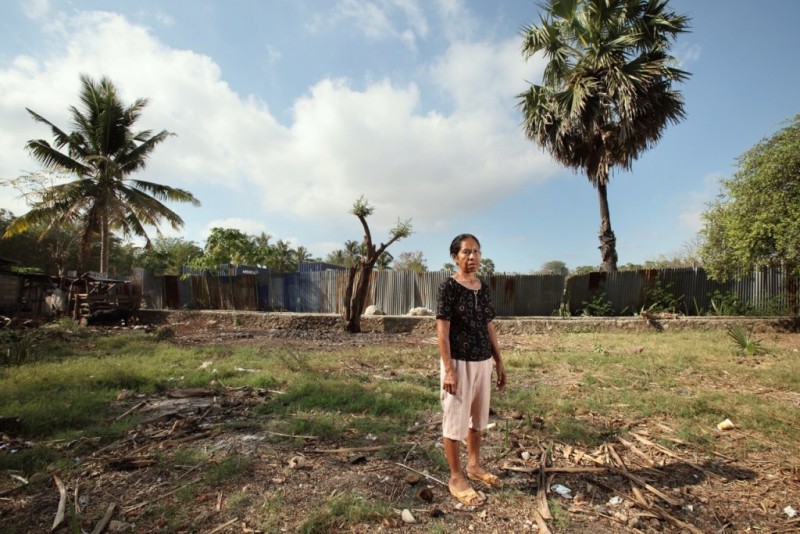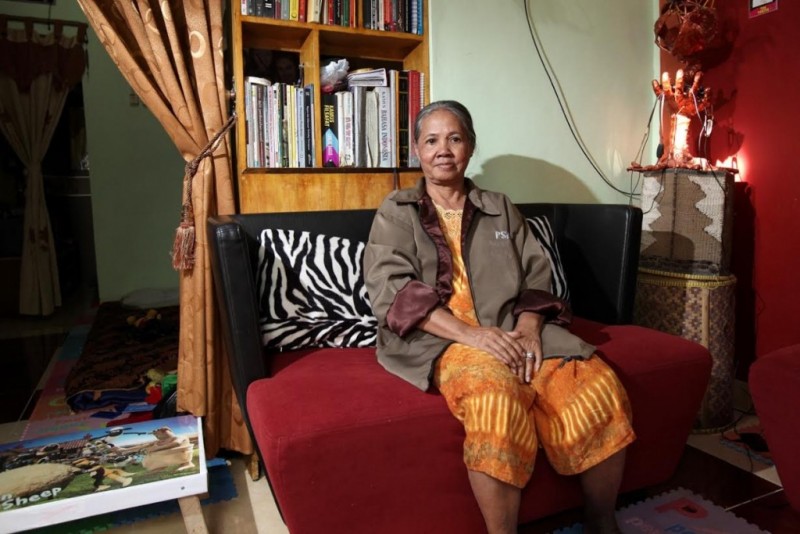 [1]
[1]Vena Taker. Nosamborina tamin'ny taona 1966 ny anadahiny sy ny rainy. “Tsy fantatro hoe nogadraina ny raiko sy ny anadahiko izay mbola tanora, na izay toerana namonoana azy ireo. Na ihany koa ny nandevenana azy ireo, tsy fantatro”. Sary avy amin'ny Asia Justice and Rights.
Ny vondrona Asia Justice and Rights dia nanatontosa [1] andiana tafatafa niaraka tamin'ireo vehivavy 26 izay sisa velona tamin'ny famonoana faobe sy ireo endrika herisetra hafa tao Indonezia nandritra ny vono olona nataon'ny fitondrana mpanohitra ny Kaominista nentin'ny miaramila tamin'ny taona 1965.
Dimampolo taona izay no lasa hatramin'ny nisamboran [2]‘ny miaramila ireo kaominista an'hetsiny sy ireo noahiahiana ho mpanohana azy, ho ampahany amin'ny fiarovana ny firenena tsy ho ao anaty lozan'ny kaominisma. Vinaniana ho olona antsasaky ny iray tapitrisa no novonoina [3] nandritra ny ftoana naha-faratampony ny fanehoana fanoherana ny kaominisma ary mbola maro koa ireo Indoneziana niharan'ny “fampijaliana, fanjavonana ankeriny, fanolanana, fanandevozana ara-nofo, ary ireo endrika hafa isehoan'ny herisera ara-nofo, fanandevozana, famonjana tsy an-drariny ary fanagadràna, famindran-toerana ankeriny, ary asa anterivozona”, taorian'ny taona 1965. Nohamarinin'ny miaramila ho famaliana faty fotsiny io, tamin'ny fiampangàny ireo kaominista ho nanafika voalohany ireo tafiky ny fanjakana.
Ny Jeneraly Suharto no teo amin'ny fitondrana nandritra io fotoana io ary nijanona ho filoha teo hatramin'ny taona 1998, raha voatery niala noho ny fikomiam-bahoaka. Fony teo amin'ny fitondrana, noraràn'i Suharto ny media, ny akademia, na ny vahoaka tsy hifanakalo hevitra na hanadihady mikasika izay tena nitranga tamin'ny taona 1965. Taty taorian'ny fialàny vao nisy izany, rehefa tonga niroso hizara ireo tantarany, ireo niharam-boina sy ireo vavolombelona.
Ny taona 2012, nanambara [4] ny Kaomisiona Nasionaly momba ny Zon'olombelona ao Indonezia fa fanitsakitsahana goavana ireo zon'olombelona no nataon'ny tafika tamin'ny taona 1965.
Ny volana Aogositra lasa teo ny Filoha Jokowi, nanolotra hevitra [5] hamoronana kaomisiona fampihavanana mba hiatrehana [6] ireo olana tsy mbola voavaha mifandray amin'ny vonomoka tamin'ny taona 1965. Azo tsapain-tanana ny lanja mavesatry ny fifikirana amin'ny lova navelan'i Suharto, na izany aza, rehefa nolavin'ireo antoko politika lehibe indrindra sy ny tafika ao Indonezia ny sosokevitr'i Jokowi.
Tamin'ity volana ity, nofoanana [7] ny fetiben'ny haisoratra nikendrena ny hizaràna ireo tantara nisy tamin'ny taona 1965 noho ny tsindry nataon'ny fanjakana.
Saingy raha toa ny fanjakana miahotra ny tsy hitodika sy hisaina ireo lesona nentin'ny vono olona tamin'ny taona 1965, vahoaka sy vondrona maro ao Indonezia no vonona hihady hatramin'ny fotony ny lasa, sady hitaky ny rariny amin'ny anaran'ireo niharam-boina noho ny herisetra sy ireo heloka bevava hafa namelezana ny maha-olombelona.
Efa karakaraina [8] ao La Haye ny Fitsarana Iraisam-pirenen'ny Vahoaka, ny volana ho avy io, mba hanadihady ny andraikitry ny fanjakana Indoneziana mikasika ny herisetra tamin'ny taona 1965.
Mandritra izany fotoana izany, ny fikarohana nentin'ny Asia Justice sy Rights dia fomba iray mandratra fo hahazoam-baovao mikasika ny olon-tsotra izay niaritra herisetra sy fanavakavahana nandritra ny ampolo taona, nandritra ny fitondran'i Suharto. Maro tamin'ireo vehivavy sisam-paty no vady na zanaka vavin'ireo gadra politika [9] sy ireo noahiahiana ho mpankasitraka ny kaominista. Mampahatsiahy antsika ireo tantara ireo fa mbola mitohy [10] ho fangatahana ifotony ara-politika mbola tsy tanteraka ao Indonezia, ny fitadiavana ny marina sy ny rariny.
 [1]
[1]Frangkina Boboy. noahiahiana ho tafiditra tao anaty Antoko Kaominista ny rainy, ary nosamborina sy nogadraina ny taona 1965. “Nanana tany tao Lasiana ny raiko – trano iray sy tanimbary – saingy nalain'ny fianakaviany daholo ireo noho izy voalaza fa lasa kaominista. Tsy nanana n'inona n'inona intsony izahay, ka tsy maintsy nitokona nibodo azy io, izay raha ny marina dia fananan'ireo ray amandreniko ihany “. Sary avy amin'ny Asia Justice and Rights
![Migelina A. Markus, detained in 1965 along with both of her parents and her siblings. "The ‘65 tragedy made us lose our parents, my older brother, and there were a lot of disappearances without any trial or evidence [showing] they had betrayed the state or nation. I want to testify so that people know the truth about the events we experienced." Photo from Asia Justice and Rights](https://globalvoices.org/wp-content/uploads/2015/10/migelina-800x534.jpeg) [1]
[1]Migelina A. Markus, voasambotra tamin'ny taona 1965 niaraka tamin'ireo ray amandreniny sy ny mpiray tampo aminy. “Ny lozaben'ny taona '65 nonamoizanay ny ray amandreninay, ny zokiko lahy, ary marobe ireo nanjavona tsy nisy fitsarana na porofo [naseho] fa hoe namadika ny fanjakana na ny firenena izy ireo. Maniry ny hijoro ho vavolombelona aho mba hahafantaran'ny olona ny marina mikasika ireo zava-nitranga niainanay.” Sary avy amin'ny Asia Justice and Rights
![Lasinem's husband was arrested and tortured in 1969, and eventually sent to Buru Island. "[My husband] was picked up by soldiers, his own friends, and taken to the village office (Kelurahan). He was beaten, sat upright in a chair and beaten. His back was trampled on until he was wounded all over. At first I was confused and scared, terrified, and I realized I had lost my protector, and my source of financial support. What about my young children? They need to eat!…I’m still wounded because I remember things that happened in the past… There is still a wound in my heart." Photo from Asia Justice and Rights](https://globalvoices.org/wp-content/uploads/2015/10/lasinem-800x534.jpeg) [1]
[1]Nosamborina sy nampijaliana ny vadin'i Lasinem tamin'ny taona 1969, sady mety nalefa tany amin'ny Nosy Buru nony farany. “[Ny vadiko] dia nosamborin'ireo miaramila, namany ihany, ary nentina tany amin'ny biraon'ny tànana (Kelurahan). Nokapohina izy, napetraka mahitsy teo ambony seza sady nokapohana. Nosihosena ny lamosiny mandra-paratrany manontolo. Tamin'ny voalohany, very hevitra aho sady natahotra, nihorohoro mafy, ary nahatsapa aho fa very mpiaro sy mpiahy ara-bola. Hanao ahoana ireo ankizikeliko? Mila misakafo izy ireo!… Mbola maratra foana ny foko satria tadidiko ireo zavatra nitranga taloha… Mbola misy ratra foana ato am-poko ” Sary avy amin'ny Asia Justice and Rights
 [1]
[1]Nianatra tamina sekolin'ny mpampianatra iray tao Yogyakarta i Kadmiyati ny taona 1965 raha nosamborina. “Rahoviana no hisy ny rariny? Iza no tena biby fiaina sy ratsy fanahy? Ireo kaominista ve? Sa ireo olon-dratsy mpamono olona? [Tsy maintsy izahay] mitady ny marina.” Sary avy amin'ny Asia Justice and Rights
 [1]
[1]Hartiti. Nosamborina tamin'ny 1966, maty noho ny tsy fahasalamana ny iray tamin'ireo zanany fony izy tany ampigadràna. “Zara raha ampy taona hahatakatra ny fahorian-dreniny ilay zanako voalohany. Nisaina an'io izy mandrapaha-fatiny. Matetika izy nandre vaovao nikasika ahy foana. Maty vokatry ny fahenoany ireo olona nitantara zavatra nankarary azy izy.” Sary avy amin'ny Asia Justice and Rights
 [1]
[1]Oni Ponirah. 17 taona izy raha voasambotra tamin'ny taona 1965. “Nilazàna aho fa hoentina mba halaina am-bavany. Raha ny tena fandehany, hogadraina mandritra ny 14 taona aho. Nanomboka ny taona 1965 hatramin'ny faran'ny taona 1979… Tsy mbola nahazo ny rariny mihitsy izahay. Manantena aho fa hiala tsiny amin'ireo niharan-doza ny governemanta.” Sary avy amin'ny Asia Justice and Rights.